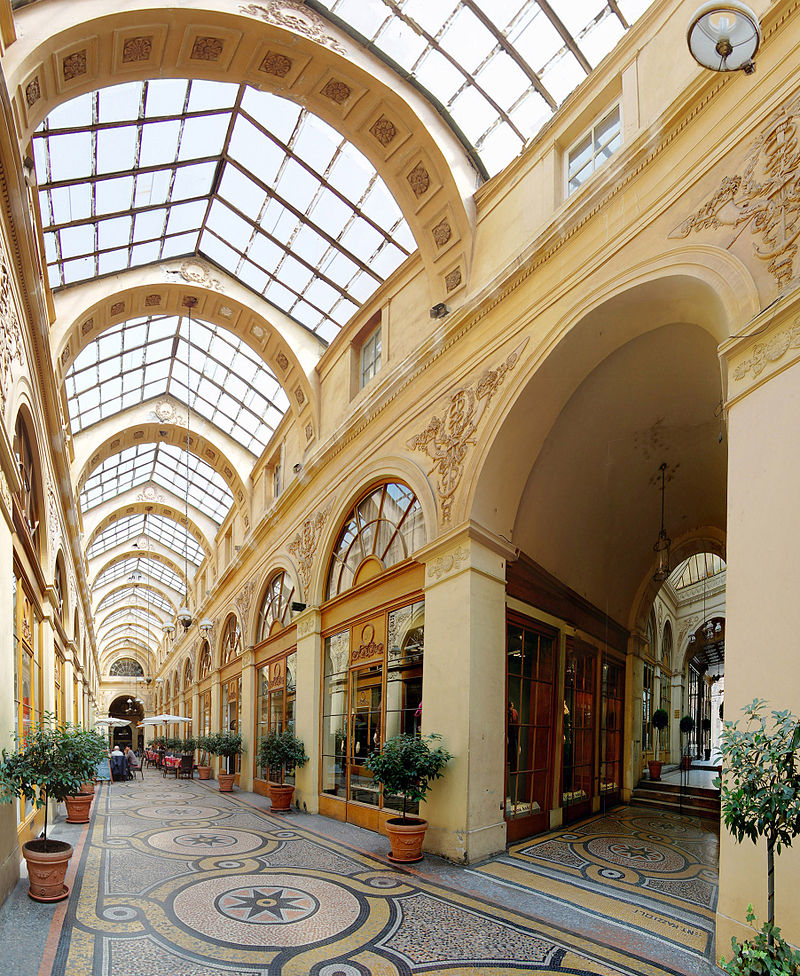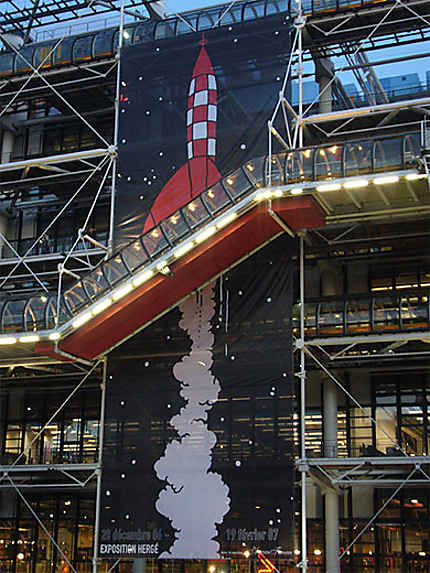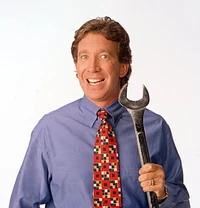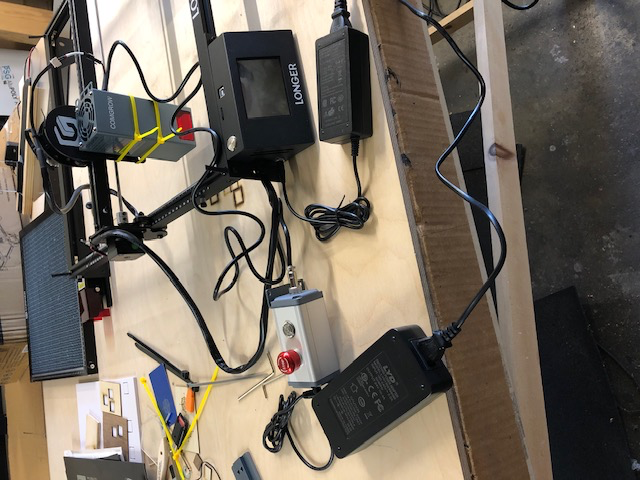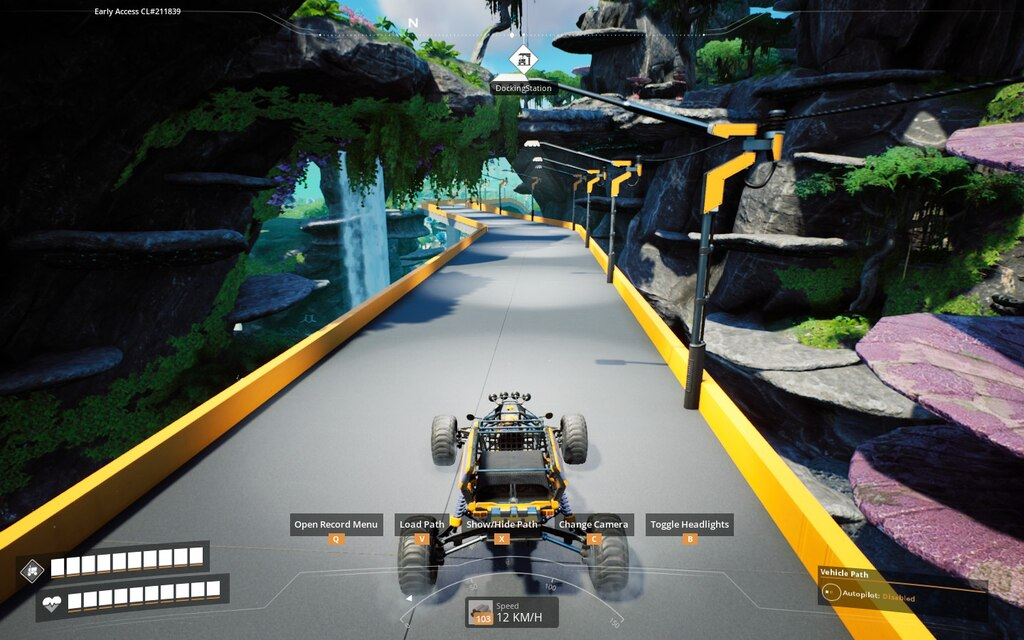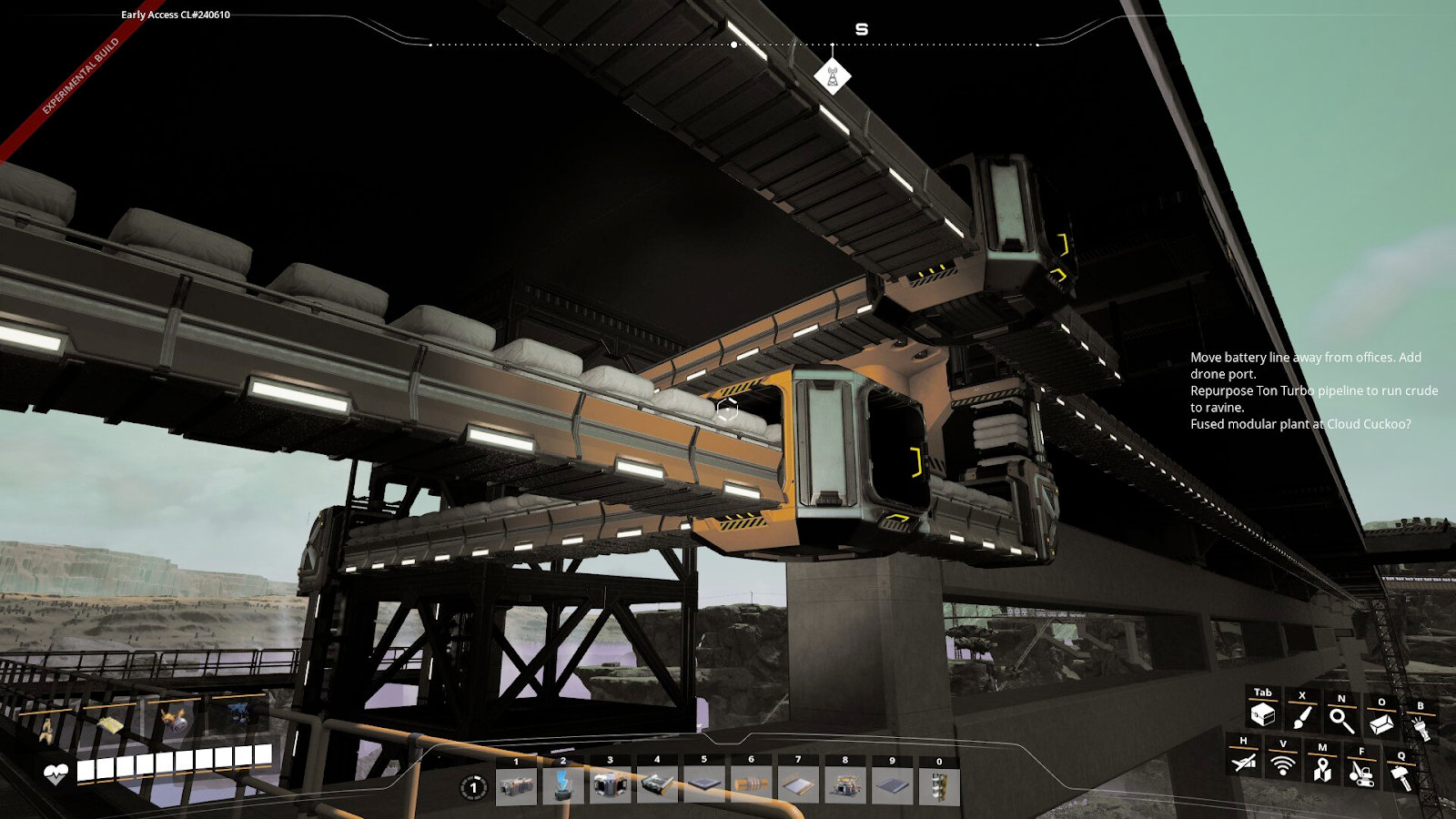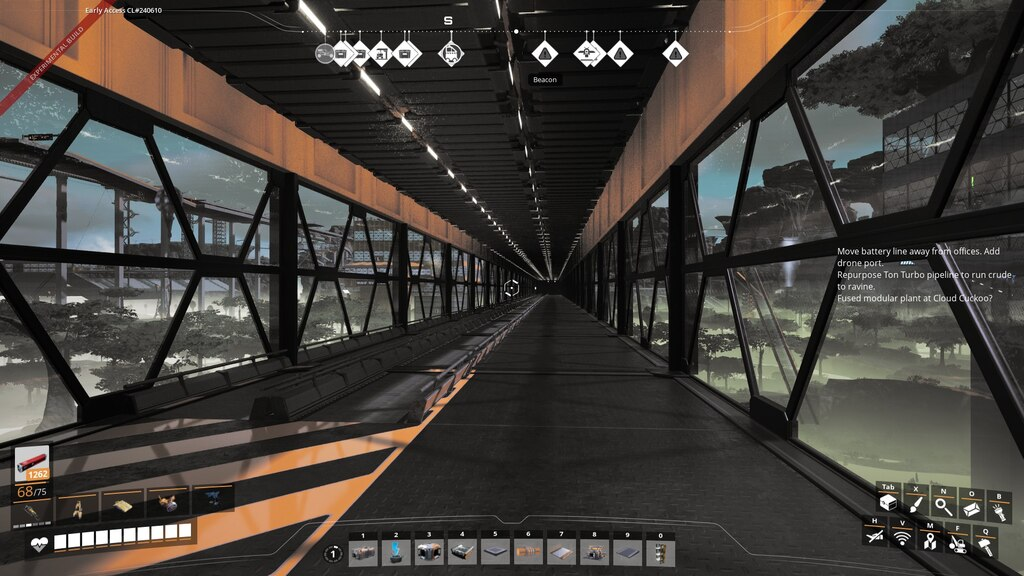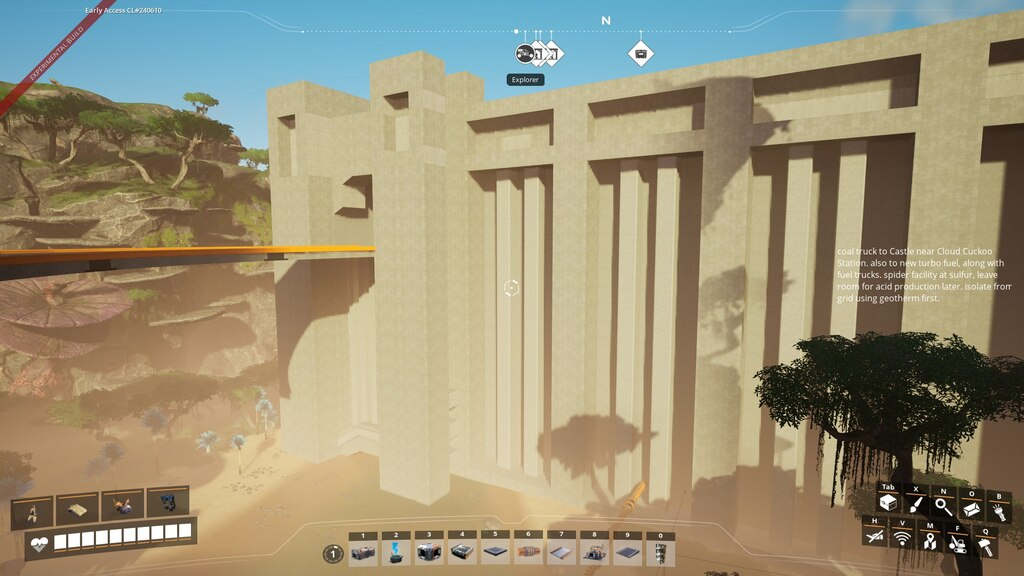Satisfactory does a wonderful job of keeping you hooked by balancing various challenges. One thing is that (with the exception of the shrubbery, which doesn't grow back) the actual resources are inexhaustible. What makes them challenging is getting to them, transporting them...and transporting yourself while you work on that transport infrastructure.
In the early game, you run conveyor belts along the ground. And you run, too, back and forth between the machines you are hooking up. This doesn't work as well, though, when you need some bauxite and it is two kilometers away from home base, in a festering swamp, filled with poison gas clouds and swarming with giant killer spiders.
As you get deeper in the game, the resources become spread across more and more physical space, and you need them in larger quantities, too -- too large for "stuff it in your pockets" to be the best option.
This is an absolutely built-in progression. The game is designed to confront you with paradigm change as the resources move out beyond easy conveyor belt range. The game starts with that technology unavailable -- you are hand-carrying buckets of raw ore from portable digging machines to your smelters. Conveyor belts themselves are the first change you adapt to.
And it is what I like to call Newtonian; you get belts and pipes, then you get trucks, then you get a monorail cargo train. But at every stage, there are places where you are still stuffing your interdimensional pockets (yes, the game states this explicitly) with the twenty sheets of copper that really need to be over there. All the previous technologies still have their part to play.
They also feed off each other. You pretty much need a work train in order to carry all the stuff you need to build the rails. Even if most of the time the train is idling and you are out there hauling bags of concrete manually!
***
For some reason I wanted to try to really, really prioritize trucks. A good road network gives you both personal and cargo access across a decent-sized area. Besides, it can be a cool aesthetic.
Roads are easy enough to build. Curves or anything other than right-angles are a pain. The least painful and best-looking method is the twelve-foundation snap; run twelve foundations at right angles to where you want the curve to start. Use option to snap another foundation on top of #12, rotate it one tick, then zoop back twelve spaces to your starting point. Keep rotating and zooping, five degrees of road turn at a time.
Ramps, I personally feel, look even less elegant. And dressing the road is a challenge because almost nothing in the game wants to follow those curves and angles properly. Find the right thing, and it can look okay. A little simple, but okay.
Two things went wrong with this big plan of all roads, all the time. The first was blueprints. Blueprints are an automation of building itself, unlocked in mid-game. With a blueprint, you can construct something more complicated than you would want to do by hand. Well, certainly not mile after mile.
The way I chose to make my blueprinted roads, though, was by baking in the option for pipelines, conveyor belts, and even hypertubes.
Version one was to hang everything under the roadway, with an elaborate catwalk network to access it. Well, that didn't work great. The catwalks were inconvenient and I still spent a lot of time trying to jetpack around under my roads and falling to my respawn more than once. They also looked really ugly around curves and cluttered up the top of the road with railings and access stairs.
The next versions I moved the stuff on top. Then I started stripping them down, simplifying the roads...mostly taking out all the stuff that really didn't want to go around curves.
Slowly, it started to work. Having a solid base for conveyors can help. Pipes are even more flexible when set up this way. It did end up getting a bit elaborate routing the stuff on and off the roadway, though:
And blueprints? You can't blueprint a curve. Level changes are hard to line up. And none of the connections actually connect, meaning you still have to climb around under hooking up pipes and wires.
Wires? Yeah; I was using the roadways as my grid as well. That is, until Update 8 added nifty-looking power towers that could be run long distances, and Priority Power Switches so you don't actually have to track down where exactly a remote facility is getting power so you can take it off line.
***
But I never did quite get to the truck phase. I am still under-utilizing that. Finally set up a power plant dependent on the trucks getting there. My first big truck experiment was my "Army Base" facility in the desert:
There's something to be said for that aesthetic, too. The turbo-fuel power plant was a little more gussied up:
And of course in keeping with my "spider-free" play mode, the remote sulfur pickup is in a safety-locked tunnel decorated with warning signs:
But the thing that was getting increasingly annoying was not moving industrial lots of material around (that will come: I have the last, huge, Space Elevator delivery to make). What was annoying was personally getting around. Trucks just weren't fast enough for my taste (the fastest thing in the game, without exploits that is, is the monorail train.)
And finding the stuff I was looking for when I got there. Too much wasted time running up and down factory aisles grabbing loose parts off the conveyor belts. I've finally started setting up proper "malls," where stuff a factory is making that is otherwise rare around the map is dropped into display bins for easy pickup. Every
Satisfactory player gets into these, and they can get elaborate indeed.
This is as crazy as I've got so far:
Design-wise, that is! That's at Plastics My Boy, a factory that only makes bulk plastic to feed the big semiconductor plant in the swamp nearby. Gasoline is a by-product (most of it gets burned off so it doesn't clog the pipes, but I sent some to a bin for easy pickup. And the quickwire is there because that resource node was in the same direction...so the stuff is just running on the same bank of conveyor belts as the plastic.
Below is one of three pick-up points at Elcor, my combined every-thing electronics plant. Which is why the mad scramble. The smart build for container farms is making a sushi belt with smart splitters. But this is also the "belt-straightening room" that re-routes the spaghetti from the lower production floors so the top bring-it-all-together supercomputer floor is a little less crazy.
Electronics are late-game so by the time you get up to the radio control modules and the electromagnetic control rods you need copper, steel, plastic, aluminium, quartz...
The Fort Hood setup is sushi belt, "show-off" slow belt lifters, and so on. But the only thing that's going in there is ammunition. Come to think, I should set up some supply depots on the edge of explored territory and run the excess production out that way.
(It isn't really a combat game. Making ammo is mostly an excuse for another fun factory. The reason for the rad hazard warnings is that the best answer to those damned spiders is thermonuclear hand grenades!)
***
The other half of the equation is getting myself around. There's actually a wee trick of using conveyors as a moving pedway. With Mark V belts and a sprint start it can get up to pretty good speeds to get down those long factory corridors.
Since Update 8 and Lumen, though, corridors like that can be rather dark. Time to dress them up with lights and signage:
But that's really a stop-gap. Only good for short haul. I had been generally avoiding the hypertubes, but then I learned about hypertube accelerators. Basically, speedy thing goes in, speedy thing goes out. You maintain your entrance velocity, and the hypertube entrance gives you an extra kick.
So stack them. This is the Booster Gold blueprint; a simple LINAC of three inline tubes...and a carefully calculated airgap so you can crawl out of the tube to do maintenance.
My revised hypertube stations, meanwhile, have a double-kick on the main trunk line. This is one of the last of the "open air" stations -- it actually works better to have the main trunk as close to inline as possible. If you aim right as you fly through a station, you'll get a triple-kick to your speed. I can cross the part of the map I'm exploiting in a short enough time it doesn't feel like such a terrible chore anymore.
Slowly, I'm filling in stations, adding boosters where wanted, and making a proper public transit network. And decorating the stations:
Haven't come up with a design for the spur destinations, though. The turbo fuel demo plant has a cute landing zone outside the main doors and down a path:
I am still working on finishing the building (the plant itself is no longer in active use). This is the one I've been experimenting with architecture on:
And the new massive turbo fuel/generator farm plant went for brutalist/brick cathedral style. Just starting on the exterior decorations, of course. Spent way too long putting a viaduct over the local creek...
I am still learning and experimenting and hope to get some actually nice buildings some day. At least now I've got the stuff I need to build properly sorted, and a decent transportation infrastructure to move it around.

